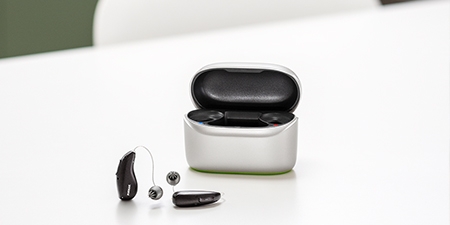Auditory Nerve Function and Anatomy

Auditory Nerve Function and Anatomy
10 min
Published September 4, 2024
Auditory Nerve Function and Anatomy
Processing Sound and Hearing Loss
The human ear is an intricate system designed to capture sounds from our environment, convert them into electrical signals, and transmit them to the brain for interpretation. Hearing loss occurs when this process breaks down, typically in the inner ear. However, the outer and middle ear can also experience blockages or damage that make hearing difficult. Understanding how each part works with the others highlights the importance of keeping your ears healthy and protecting your hearing, enabling the auditory nerve to do its job.
The Ear: A Doorway to Sound
The ear is divided into three main parts: the outer ear, middle ear, and inner ear. Each plays a pivotal role in how we hear. The outer ear, or pinna, is the only part visible to us and is usually the first thing you think of or picture when discussing ears, but there's a lot more to them than the eye can see. When you have a hearing test, what’s being measured is the performance of the interior portions. Let's take a closer look at how each part is connected and how they work together to process sounds.
The Outer Ear: The Sound Collector
The outer ear consists of the pinna (or auricle) and the ear canal. The pinna captures sound waves, funneling them down the canal to the eardrum, a thin membrane separating the outer and middle ear. This process begins our auditory experience by collecting the sounds we encounter daily. While ears appear to have a funny shape, there's a purpose to it: they help capture sounds coming from various directions.
The Middle Ear: The Sound Amplifier
The middle ear starts at the eardrum and houses three tiny bones known as the ossicles. Because of their unique shapes, these bones, the malleus, incus, and stapes, are often known by their nicknames: the hammer (malleus), anvil (incus), and stirrup (stapes). When sound waves hit the eardrum, it vibrates, causing these bones to move. This movement amplifies the sound waves, preparing them for their journey into the inner ear.
The Inner Ear: The Translator
The inner ear contains the cochlea, a snail-shaped organ filled with fluid and thousands of tiny hair cells. These hair cells move in response to the sound vibrations, converting them into electrical signals. The inner ear is also home to the auditory nerve and the vestibular system, which helps maintain balance. This close connection of the vestibular system and inner ear is why some types of hearing loss cause balance issues.
The Auditory Nerve: The Messenger
Once the cochlea converts sound vibrations into electrical signals, they are picked up by the auditory nerve. This nerve carries the signals to the brain, interpreting them as the sounds we recognize and understand. Even though this is quite an intricate process that requires every part to perform flawlessly in order to process sound, it all happens in the blink of an eye, enabling you to hear sounds around you instantly.
Facing Hearing Challenges
Hearing problems can arise from issues at any point in the anatomy of the ear or auditory nerve. Some common conditions include:
Ear Infections - Can affect the outer, middle, or inner ear, leading to temporary hearing loss.
Otosclerosis - Affects the movement of the middle ear bones.
Noise-induced Hearing Loss - Caused by exposure to loud sounds, damaging the inner ear's hair cells.
Sensorineural Hearing Loss - Results from inner ear or auditory nerve damage.
Recognizing the signs of hearing loss, which can include difficulty understanding speech, ringing in the ears (tinnitus), and sensitivity to loud sounds, is crucial. Visiting a hearing clinic or an ear specialist is your key to properly diagnosing and treating these symptoms.
Tips for Healthy Ears
Maintaining good ear health is key to preventing ear problems and hearing loss. Here are some tips people of every age should follow:
Protect Your Ears - Use earmuffs or earplugs in noisy environments.
Keep Ears Clean - Avoid inserting objects into the ear canal.
Manage Volume - Keep the volume down on headphones and earbuds.
Exercise Regularly - Your body's organs need good blood flow to remain healthy.
Regular Check-ups - Visit an audiologist for regular hearing tests, especially if you notice signs of hearing loss.
Schedule a Free Hearing Test at AudioNova
The ear's anatomy is fascinating, playing a vital role in how we interact with the world through sound. By understanding the ear's structure, function, and common issues that can affect hearing, you can take better care of your ears to reduce the risk of hearing loss. AudioNova offers free hearing tests online and in our clinics nationwide. If you have signs of hearing loss, our hearing care professionals can offer a treatment plan and explain the different types of hearing aids that can return you to better hearing. Find one of our locations near you or sign up for a test online.




